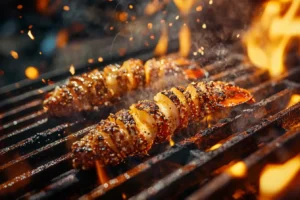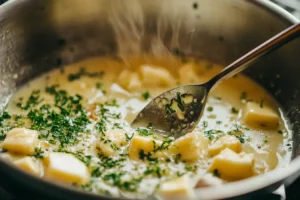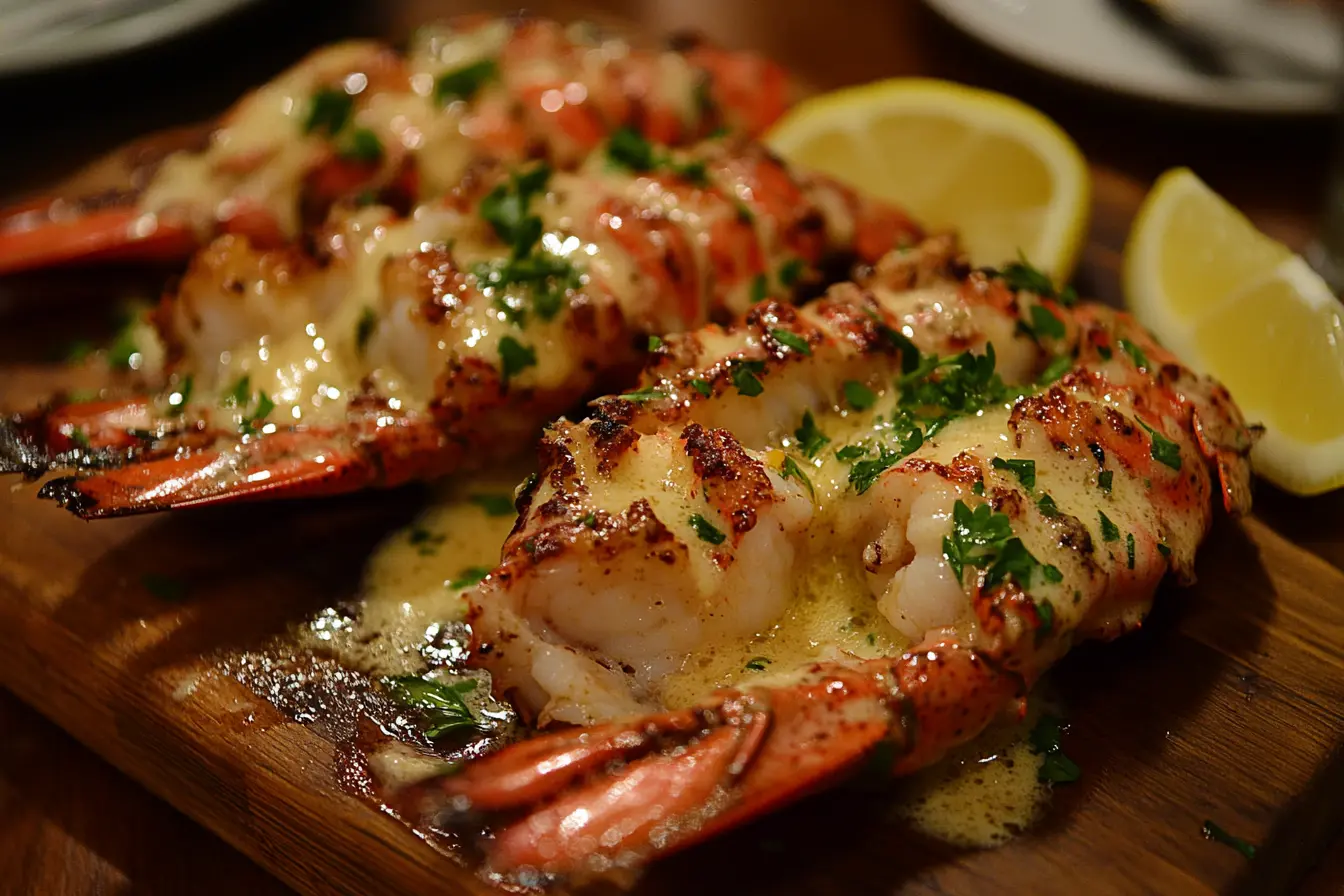Lobster tails dripping with garlic butter goodness—just the thought is enough to make your mouth water. This dish, often reserved for luxurious dinners, can be prepared right at home with ease. Whether you’re planning a romantic dinner or simply want to treat yourself, this guide will walk you through every step of making the perfect garlic butter lobster tails recipe. From selecting the freshest tails to crafting a butter sauce that elevates their flavor, we’ve got you covered. Let’s dive in!
The Allure of Lobster Tails in Culinary Delights
Historical Significance of Lobster in Cuisine
Lobster, once considered a poor man’s food, has transformed into a symbol of gourmet indulgence over the centuries. Its delicate, sweet flavor pairs effortlessly with a variety of seasonings, making it a versatile seafood choice. Historically, lobster was abundant and inexpensive, served in homes and even prisons. Today, it graces the menus of fine-dining establishments worldwide, embodying elegance and flavor.
Popularity of Lobster Tails in Modern Dining
When it comes to seafood, lobster tails steal the show. They’re prized for their tenderness, ease of cooking, and adaptability. Unlike whole lobsters, tails are less intimidating and more convenient to prepare. Their meaty texture is ideal for absorbing rich garlic butter sauces, making them a favorite for dinner parties and special occasions.
Why Choose Garlic Butter as a Complement
Flavor Profile of Garlic Butter
Garlic butter isn’t just a sauce—it’s a magical elixir that transforms any dish into a masterpiece. The buttery richness balances the natural sweetness of lobster, while garlic adds a punch of bold, savory flavor. Together, they create a perfect harmony that tantalizes the taste buds.
Pairing Garlic Butter with Seafood
Seafood and butter go hand-in-hand, but garlic butter takes this pairing to another level. Its velvety texture seeps into the delicate lobster meat, ensuring every bite is moist and flavorful. By enhancing the seafood’s natural taste without overpowering it, garlic butter becomes the ultimate complement.
Selecting and Preparing Lobster Tails
 Cooking the perfect garlic butter lobster tails recipe starts with choosing the right lobster tails. The quality of your ingredients can make or break this dish, so selecting and preparing them properly is essential. Follow these steps to ensure your lobster tails are fresh, flavorful, and ready for their buttery transformation.
Cooking the perfect garlic butter lobster tails recipe starts with choosing the right lobster tails. The quality of your ingredients can make or break this dish, so selecting and preparing them properly is essential. Follow these steps to ensure your lobster tails are fresh, flavorful, and ready for their buttery transformation.
Choosing the Best Lobster Tails
Fresh vs. Frozen Lobster Tails
Fresh lobster tails are often preferred because of their superior taste and texture. However, frozen options can be equally delicious if handled correctly. When deciding between fresh and frozen, consider your timeline. Fresh tails are ideal for same-day cooking, while frozen ones offer flexibility. Yet, always check the packaging for ice crystals or freezer burn, as these can compromise the quality.
Indicators of Quality and Freshness
When buying fresh lobster tails, look for ones that are firm to the touch, slightly translucent, and free from any strong fishy odors. Their shells should be shiny and intact without any discoloration. For frozen tails, opt for those vacuum-sealed in clear packaging to inspect their appearance. A bright color is a good sign, but beware of any dull or pale-looking meat.
Preparing Lobster Tails for Cooking
Thawing Frozen Lobster Tails Safely
Thawing frozen lobster tails correctly is crucial to maintain their texture and flavor. The best way to do this is by placing them in the refrigerator overnight. This gradual process ensures even thawing without compromising the meat’s quality. If you’re short on time, you can use the cold water method. Place the sealed tails in a bowl of cold water, changing the water every 30 minutes until fully thawed.
Techniques for Butterflying Lobster Tails
Butterflying the tails not only improves their presentation but also helps the garlic butter sauce seep into every crevice. To butterfly, start by using sharp kitchen scissors to cut along the top of the shell, stopping just before the tail fin. Gently pry the shell apart, being careful not to detach it completely, and lift the meat slightly so it rests on top of the shell. This method ensures even cooking and allows for better flavor infusion.
Crafting the Perfect Garlic Butter Sauce
No garlic butter lobster tails recipe would be complete without a rich, flavorful sauce to enhance the lobster’s natural sweetness. Garlic butter may seem simple, but its perfect balance of ingredients creates a luxurious finish for this dish. Let’s explore how to craft a sauce that’ll make your lobster tails unforgettable.
Essential Ingredients for Garlic Butter
Selecting Quality Butter
Butter is the foundation of this sauce, so choosing a high-quality option is crucial. Unsalted butter is often the best choice because it allows you to control the saltiness. Moreover, European-style butter, which contains a higher butterfat content, delivers a richer, creamier flavor that pairs beautifully with seafood.
The Role of Fresh Garlic in the Sauce
Fresh garlic, not its powdered counterpart, is essential for achieving the bold, aromatic quality of this sauce. Minced garlic releases natural oils that infuse the butter with a robust, savory taste. To avoid bitterness, cook the garlic gently over low heat until it becomes soft and fragrant. This step prevents burning, which can ruin the sauce’s delicate balance.
Enhancing the Sauce with Additional Flavors
Incorporating Herbs and Spices
While garlic and butter are the stars, adding herbs like parsley, thyme, or chives elevates the sauce’s complexity. A sprinkle of paprika or cayenne can also introduce a subtle kick. These ingredients not only boost flavor but also add color, making the dish even more visually appealing.
Adding Citrus Elements for Brightness
A touch of citrus—whether it’s lemon juice, lime zest, or a combination of both—brings brightness to the sauce. The acidity cuts through the richness of the butter and balances the lobster’s sweetness. Just a squeeze of fresh lemon over the finished dish can make all the difference, tying the flavors together harmoniously.
Cooking Methods for Lobster Tails
Preparing lobster tails to perfection depends on your cooking technique. While the methods may vary, each one ensures your garlic butter lobster tails recipe delivers succulent, flavorful results. Two of the most popular methods—broiling and grilling—bring out the best in the lobster’s natural taste and texture. Let’s explore both approaches step by step.
Broiling Lobster Tails
Step-by-Step Broiling Instructions
 Broiling is a fantastic method because it’s quick and intensifies the lobster’s flavor by caramelizing the garlic butter sauce. To begin, preheat your oven’s broiler and position the oven rack about 6 inches from the heat source. Place your butterflied lobster tails on a baking sheet lined with foil. Brush the exposed meat generously with the garlic butter, ensuring every part is coated. Broil for about 5-8 minutes, depending on the size of the tails, until the meat is opaque and slightly golden on top.
Broiling is a fantastic method because it’s quick and intensifies the lobster’s flavor by caramelizing the garlic butter sauce. To begin, preheat your oven’s broiler and position the oven rack about 6 inches from the heat source. Place your butterflied lobster tails on a baking sheet lined with foil. Brush the exposed meat generously with the garlic butter, ensuring every part is coated. Broil for about 5-8 minutes, depending on the size of the tails, until the meat is opaque and slightly golden on top.
Tips for Achieving Even Cooking
To avoid uneven cooking, always keep an eye on the lobster as it broils. Rotate the baking sheet halfway through the cooking process if necessary. Additionally, use a meat thermometer to check that the internal temperature reaches 140°F for optimal doneness. Overcooking can result in rubbery lobster, so it’s better to check frequently.
Grilling Lobster Tails
Preparing the Grill for Lobster
Grilling lobster tails imparts a smoky, charred flavor that complements the richness of the butter sauce. Start by preheating your grill to medium-high heat, around 400°F. Lightly oil the grates to prevent sticking, and brush the lobster meat with a thin layer of garlic butter before placing them flesh-side down on the grill.
Monitoring Doneness on the Grill
Grill the lobster tails for about 5 minutes on each side, brushing more garlic butter on the meat as they cook. Flip the tails carefully with tongs to avoid tearing the delicate meat. When the meat turns opaque and firm to the touch, they’re ready to serve. For extra flair, brush a final layer of garlic butter over the cooked tails right before plating.
Serving Suggestions and Accompaniments
Once your garlic butter lobster tails recipe is cooked to perfection, the next step is to consider how to serve it. Presentation and pairing can elevate your dish from delicious to truly memorable. By choosing the right side dishes and beverages, you can complement the flavors of the lobster while creating a well-rounded meal.
Ideal Side Dishes for Garlic Butter Lobster Tails
Vegetable Pairings
Vegetables bring balance to the richness of the lobster and garlic butter sauce. Steamed asparagus, roasted Brussels sprouts, or sautéed green beans provide a fresh, crunchy contrast. You can also include a vibrant salad with leafy greens, cherry tomatoes, and a light vinaigrette to add a refreshing touch. Don’t forget to drizzle a bit of lemon juice on the vegetables to tie the flavors together seamlessly.
Starch Options to Complement the Dish
Adding a starchy side can make the meal feel more substantial without overpowering the lobster’s delicate taste. Creamy mashed potatoes, fluffy rice pilaf, or a simple pasta tossed with olive oil and herbs work wonderfully. For something a bit more indulgent, try serving crusty bread or dinner rolls, which are perfect for soaking up every last drop of the luscious garlic butter sauce.
Wine and Beverage Pairings
Selecting Non-Alcoholic Beverages to Consider
To enhance the lobster’s sweet and savory notes, consider pairing it with a refreshing beverage like sparkling water with citrus or herbal tea with lemon. For a summery feel, a chilled fruit-infused water, such as cucumber and lime, can also be a great choice. These options help cleanse the palate while highlighting the dish’s flavors.
Crafting a Complete Presentation
When plating your lobster tails, remember that visual appeal is as important as taste. Arrange the lobster tails on a large platter, garnished with fresh parsley or lemon wedges for a pop of color. Add your chosen sides in separate sections, ensuring each element shines while creating an inviting, cohesive look.
Nutritional Information and Considerations
Lobster tails are not only delicious but also packed with nutrients, making them a great choice for a wholesome meal. By combining them with a garlic butter sauce, you can create a dish that’s both indulgent and nutritionally satisfying. However, it’s important to understand the nutritional profile of lobster and how to adapt the recipe for specific dietary needs.
Nutritional Profile of Lobster Tails
Macronutrient Breakdown
Lobster meat is a lean protein source, containing about 19 grams of protein per 3-ounce serving. It’s low in fat and carbohydrates, which makes it ideal for those following high-protein or low-carb diets. Additionally, the natural sweetness of lobster eliminates the need for heavy seasonings, allowing the garlic butter sauce to complement its flavor without masking it.
Vitamins and Minerals Present
Lobster is rich in essential vitamins and minerals, including vitamin B12, zinc, copper, and selenium. These nutrients are crucial for maintaining energy levels, supporting a healthy immune system, and promoting proper cell function. Moreover, lobster tails are a good source of omega-3 fatty acids, which are known to benefit heart health and reduce inflammation.
Health Considerations
Managing Cholesterol Intake
While lobster meat itself is relatively low in cholesterol compared to other seafood, the garlic butter sauce can add significant amounts of saturated fat. To reduce cholesterol intake, consider using a smaller portion of butter or replacing it with a heart-healthy alternative, such as olive oil. Additionally, balancing the meal with fiber-rich sides like vegetables can help mitigate the impact of cholesterol on overall health.
Modifying the Recipe for Dietary Needs
This recipe can easily be adapted to suit various dietary preferences or restrictions. For a dairy-free option, replace butter with plant-based margarine or coconut oil. If you’re watching your calorie intake, reduce the amount of butter or garlic and serve the lobster tails with a light citrus glaze instead. These adjustments ensure the dish remains flavorful while meeting individual nutritional goals.
Frequently Asked Questions (FAQs)
Can I Use Pre-Cooked Lobster Tails?
Yes, pre-cooked lobster tails can be used, but you’ll need to be extra cautious to prevent overcooking. Pre-cooked lobster tails only require reheating, so focus on brushing them with garlic butter sauce and warming them gently under a broiler or in a pan. This ensures they stay tender and moist while still absorbing the flavors of the sauce.
How Do I Store Leftover Cooked Lobster?
To store leftover lobster, place it in an airtight container and refrigerate it within two hours of cooking. Properly stored lobster can last up to three days in the fridge. If you’re planning to keep it longer, freezing is the best option. Wrap the tails tightly in plastic wrap and place them in a freezer-safe bag for up to three months. When reheating, thaw them overnight in the refrigerator and warm gently to avoid drying out.
What Are Alternative Sauces for Lobster Tails?
Although garlic butter sauce is a classic choice, there are other options to suit different tastes. Lemon dill sauce, made with fresh dill and Greek yogurt, provides a tangy and refreshing alternative. Another option is a light herb-infused olive oil with parsley and thyme, which enhances the lobster’s natural sweetness without overpowering it.
How Can I Prevent Lobster Tails from Becoming Tough?
The key to tender lobster tails lies in proper cooking time. Overcooking is the primary culprit behind tough meat, so always monitor your lobster closely. Use a thermometer to check for an internal temperature of 140°F. Additionally, basting the meat with garlic butter sauce throughout the cooking process helps maintain its moisture.
Is It Possible to Bake Lobster Tails Instead?
Absolutely! Baking is a gentle cooking method that works wonderfully for lobster tails. Preheat your oven to 375°F, place the butterflied tails on a baking dish, and brush them generously with garlic butter. Bake for 15-18 minutes, depending on the size of the tails, until the meat turns opaque. For added flavor, finish with a quick broil to caramelize the garlic butter.
What Is the Best Way to Reheat Lobster Tails?
To reheat lobster tails without drying them out, wrap them in foil and place them in a 350°F oven for 10 minutes or until warmed through. Alternatively, you can reheat them gently in a skillet with a bit of garlic butter sauce. Avoid microwaving, as it often results in uneven heating and a rubbery texture.

